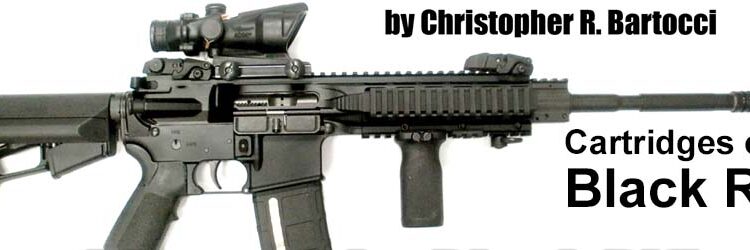By Christopher R. Bartocci
There is absolutely no question that the AR-platform is the adult Erector Set. You can have whatever you want and make it do whatever you want. No weapons platform has ever been as modular. Originating at the 7.62x51mm caliber and then scaling down to the 5.56x45mm, nobody ever thought about all of the in-between. Today there are many different calibers that these weapons can be had or converted into. While based on the 5.56x45mm version, this author has found at least 20 different calibers. That is not to say there are not more of them out there. They range from .22 cal., 6.8, .30, .311 right on up to .50 caliber. Based on the AR-10 version we see at least 6 different calibers from .243, .264, .284, .308, and .338 inch diameter projectiles. We even see pistol calibers from 9x19mm right up to 45 Auto. This article contains a list and description of the most popular cartridge variations for the Black Rifle.

AR-15 Platform
5.56x45mm/.223 Remington
The .223 Remington cartridge and the AR-15 were developed together and have both gone through changes. Originally with a 1 in 14 inch twist barrel and then standardized in the 1 in 12 by the U.S. military and later to the 1 in 7 with the adoption of the 5.56x45mm NATO round, this is the most popular chambering by far in the black rifle. Commercial barrels have been offered in several different rifling twists including 1/8, 1/8.5 and 1/9. The 1/14 and 1/12 stabilize reliably the 40 through 55 grain projectiles. The 1/9 stabilizes from 55 to 69 grain projectiles reliably and the 1/7 stabilizes the 55 to 80 grain projectiles reliably. There are an abundance of bullet weights and types available in this caliber ranging from 40 to 80 grains. Projectiles are from hollow points, soft points, full metal jackets, solid copper, bonded projectiles, frangible, tracer, armor piercing, gold dot and many more. Ammunition is available from all over the world as well as military surplus. The cartridge is very reasonably priced and suitable for target shooting, competition, self defense and hunting small game. This is perhaps one of the most popular cartridges in the country used by military, law enforcement and commercial customers alike.
.222 Remington
Very few black rifles were made in the 222 Remington caliber. Colt did two runs of these rifles which were meant for export only. There are countries throughout the world which permit civilian ownership of firearms but prohibit ownership of military calibers. So the barrel was chambered for the .222 Remington caliber and the buffer was modified. Colt did a run of these in the SP1 model as well as one more in the A2 Sporter II model. (France is one country that these were sold in)

.204 Ruger
The .204 Ruger was a joint venture between Ruger and Hornady and the second named Ruger cartridge between the two companies. Released in 200r the cartridge was made from necking down a .222 Remington Magnum cartridge case to accept a .204 inch diameter projectile. The cartridge has projectile weights from 26 to 50 grains. The velocity of a 32 grain projectile is an incredible 4,225 feet per second with a 45 grain projectile at 3,625 feet per second making this the fasted projectile launched by the black rifle. These velocities are made possible by modern propellants. Ammunition is made commercially by Hornady, Remington, Winchester, Fiocchi, Nosler Custom, HSM and Corbon and others.
Black rifles in this caliber have been manufactured by DPMS, Remington, Lesbaer, Double Star and LMT (MRP stainless steel) to name a few. Several barrel manufacturers make just the barrel enabling shooters to build their own upper as well. This is an incredible rifle for varmint hunting boasting ½ MOA accuracy.
5.45x39mm
One of the newer chamberings is the 5.45x39mm. There has been a significant influx of Russian 5.45x39mm ammunition into the U.S. Smith & Wesson M&P15R was one of the first to offer an AR-type rifle in this caliber. This cartridge is far more conducive to the AR-platform than is its 7.62x39mm counter-part. Rifles have been made by Adams Arms, Model 1 Sales, Spikes Tactical and Olympic Arms to name a few. LMT has also introduced a barrel for their MRP platform.
The 5.45x39mm cartridge is reliable in this platform as well as accurate. Ammunition is very inexpensive compared to even 5.56mm ammunition on today’s market. Hornady has introduced a tactical 60gr V-Max load for self defense and hunting small game. This cartridge can be found in 53, 55, 60 and 62 grain projectiles either full metal jacket, hollow point or V-Max configurations. This cartridge case is only available in steel cases/berdan primed. This is necessary due to the pressures involved; the rim would sheer off during extraction if a brass case was used. This is an excellent choice for inexpensive plinking and self defense. There are many manufacturers to choose from as well.
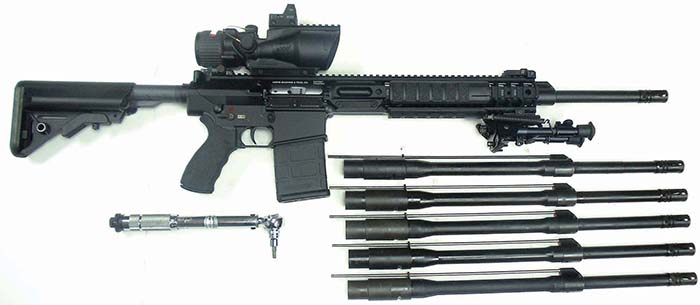
7.62x39mm
Most every modern military rifle has been chambered in the 7.62x39mm cartridge and the Black Rifle is no exception. The first to come on board with this was Colt in their Sporter series. This was to permit the rifle to be used for medium game hunting as well as take advantage of the cheap surplus Chi-Com and Russian ammunition. Later, Knight’s Armament would develop a rifle called the SR47 for Special Operations request. Currently ArmaLite produces an M15 in this caliber as well as LMT produces a barrel for their Monolithic Rail Platform.
The reason this has not really caught on is mainly due to the inability to reliably feed this cartridge in an AR-platform rifle. The natural curvature of the 7.62x39mm cartridge case has a significant taper and is the reason for the curvature of the AK magazine. The rounds do not sit properly to reliably feed. There are several magazine manufacturers out there but none that would make the rifle combat reliable. Another issue is the lack of a selection of projectiles in the .311 diameter. There are a limited amount of projectile weights and configurations available. The normal projectile weights are 122, 123 and 124 grains and the projectiles are normally full metal/steel jacket, soft point, hollow point or the Hornady SST. This cartridge is available in brass cartridge cases so they may be reloaded. The cost of the ammunition makes reloading very hard to justify. Some manufacturers have adapted the lower receiver of the Black Rifle to accept AK-type magazines. They are too new to get a handle on their reliability.

6.8x45mm Remington SPC
Since the 1970s, with the development of the .280 British and the American 6mm SAW programs, there has been thought that the 6mm caliber was the ideal military caliber. Around the 2000/2001 time period former 5th Special Forces MSG Steven Holland developed from the .30 Remington cartridge case a new 6.8x45mm cartridge. With the assistance of United States Army Marksmanship Unit Ammunition Section headed by Troy Lawton, initial assessments of the new cartridge were made and then the program was picked up for final development at no cost to the government by Sean Dwyer of Remington Arms. Prior to SAAMI acceptance and final configuration specifications for the cartridge several companies manufactured rifles to fire this new cartridge. Experimental ammunition went into production in early 2002 and went into full production by Remington in the summer of 2003. One company does stand out as the leader in development of the 6.8mm Remington SPC, and that is Silver State Armory. They have developed more types of loads for various purposes than any other company including a very effective armor piercing round. They are also the only company to offer the “tactical” line which is only for use in Spec 2 chambers, which create higher pressures really giving the full benefit of this cartridge. The SAAMI spec is the Spec 1 chamber. This enabled commercially produced ammunition to be used in all the earlier rifles that were made. The Spec 2 chamber has modifications enabling higher pressures. The shooter must know what chamber he has and use the proper ammunition. Most chambers in production today are the Spec 2. The primary load for this cartridge is a 115 grain projectile normally firing with a muzzle velocity of 2,650 feet per second. Silver State Armory offers projectiles in 75, 85,100, 110, 115 and 140 grains. The projectiles range from open tip match, soft point, frangible, Barnes TSX, Accubond and armor piercing, among others.
The base of the cartridge case is larger requiring a separate bolt than the standard 5.56 bolt. There is also a separate magazine for the cartridge mainly made by PRI and C-Products. Complete rifles have been made by many manufacturers including ArmaLite, DPMS, Rock River, Barrett, Bushmaster, LMT (MRP), Remington, LWRCI, Ruger, Spikes Tactical, Wilson Combat, Stag Arms and CMMG. This cartridge has not been entirely successful on the military market. Recently LWRCI was awarded a contract in the Middle East, the first large scale military contract for this caliber firearm. Time will tell how well it does. However, this cartridge has been extremely popular in the commercial/hunting market and has seen some acceptance in the military market. Ammunition is readily available for this cartridge by Remington, Silver State Armory, Hornady, S&B, CORBON, Barrett and HSM to name a few.
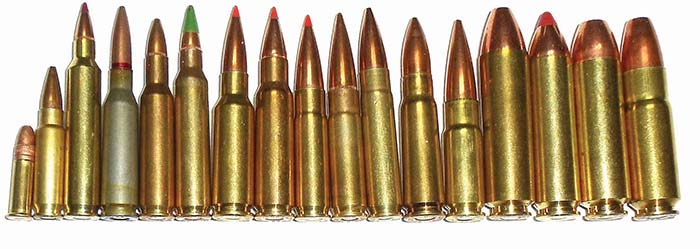
6.5 Grendel (6.5x38mm)
Introduced in 2004 by Bill Alexander, the president of Alexander Arms, the 6.5 Grendel initially developed as a competition and a hunting cartridge that could be placed in a black rifle. It was not until after its introduction that its military applications were realized. The overall length of the cartridge would fit in the black rifle magazine. This cartridge became a SAAMI standard round in 2012. Designed to create an effective range from 200 to 800 yards with a .264” (6.5mm) projectile that has been debated for many years as the ideal service rifle projectile. Projectile weights go from 90, 108, 120, 123 and 130 grains. With a 123 grain Sierra MatchKing projectile, the muzzle velocity is 2,650 feet per second. Ammunition is produced by Hornady, Wolf, Alexander Arms, Precision Firearms and Black Hills Gold.
Due to the larger cartridge base, which is the same as the 7.62x39mm cartridge, a modified bolt is needed. The way the rounds stack in the magazine, a new magazine and follower were developed for this chambering as well. The magazines have mostly been made by C-Products. The rifles have been manufactured by Alexander Arms, Sabre Defense and JP Enterprises. Many rifles are custom built in this caliber. The number one nemesis of the 6.5 Grendel is the 6.8mm SPC, and that will not change. But this is a force to be reckoned with and will not be going anywhere in the foreseeable future.
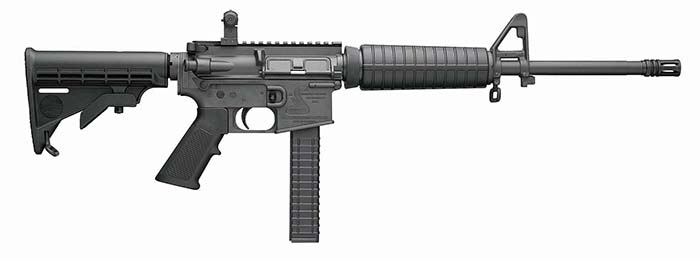
300 Whisper/300 AAC Blackout (7.62x35mm)
The destiny of these two cartridges are very tightly intertwined, which is why I am speaking of them together. The 300 Whisper is the design of JD Jones of SSK Industries. In his own words on the development of this cartridge: “I started developing the Whisper in late 1991 or fairly early 92. Copyrighted it in Nov 1992 and released it about that time. Development was extensive with 125-250 grain bullets, which will all function through the SSK 300 Whisper AR. Now we can do 290 grains. First chambering was in the Contender for basic load development. Next was in the AR and bolt guns. There was a lot of fiddling around with the gas system. The single port worked ok with heavy bullets and WW 680 or surplus 1680 powder but that was about it. The powder was burning well under its optimum rate – pressure and quite dirty – particularly with suppressor on it. This is very important for military use. In one test at Bragg they went through about 1,300 rounds with the can on without a malfunction in around 30 minutes but not with 1680 powder. This doesn’t seem to have changed. Quite a few HV loads gave too high a port pressure and excessive bolt velocities and rates of full auto fire. That is why I went to the short two-port gas system to make use of cleaner burning and more uniform velocity powders. This is particularly important in short barrels. One load we had developed and loaded quite a bit of is the 220 Sierra MatchKing at 1,400 fps from a 10-inch M16. Try that one for a single non adjustable port and even more a 125 at 2100+ from a 10-inch barrel. At the time 221 was the obvious choice of brass. No one in their right mind wants to cut off 223, form it and check neck wall thickness and case capacities. This can still be problem. I had LC 5.56 and all case necks were swaged for infirmity and none of the overly thick necks were acceptable. In addition if you cut a 5.56 off, neck it and measure wall thickness you will see it is tapered; which gives excessive bullet runout and poor accuracy in many cases. This continued until the guy died. T/C was the first licensed to use it and it became quite popular in Handgun Metallic Shooting and for hunting of deer sized game. Corbon made the first commercial ammo for it. One of the big ammo companies felt turned down making brass and the other asked for a PO for a million rounds of loaded ammo to “consider” it.”
The 300 Whisper cartridge case was made from a .221 Remington fireball cartridge case that is necked up to accept the .308 diameter projectile. The concept was to have one cartridge that could fire rounds that were both supersonic and subsonic. Supersonic loads vary from 110, 125 and 150 grains available commercially. The subsonic ammunition available in 208 and 220 grain projectiles commercially coupled with a suppressor provided silent sentry incapacitation by firing a 220 grain projectile at 1,040 feet per second and then by removing the suppressor and putting supersonic ammunition in the rifle you had the power of an AK 7.62x39mm firing a 125 grain projectile at 2,100 feet per second in a reliable AR platform. Best of all, only the barrel need be changed to fire the 300 Whisper. Both the bolt and the magazine are the exact same. No modifications are made to the magazine and they are fully loaded to capacity. The main issue found from research with this caliber is that it was never approved by SAAMI. This means there were no single prints of the chamber and cartridge as well as safe loads. Few manufactures made this caliber with the exception being Hornady, Corbon and Black Hills. This load was the basis for the 300 Fireball and the 300-221 and the 300 Blackout.
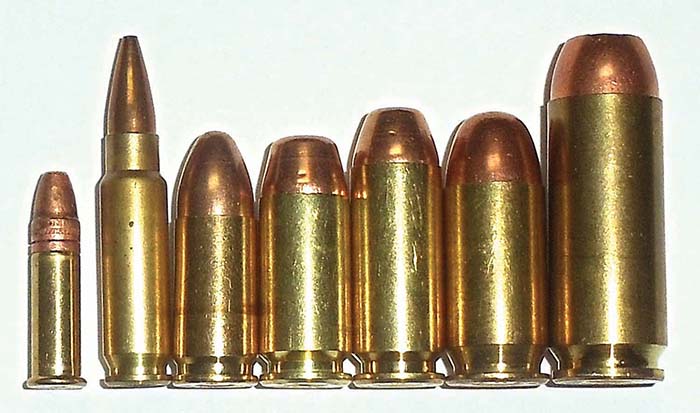
The 300 Blackout set out with similar goals as the 300 Whisper but this time headed by the Freedom Groups companies AAC and Remington. With the substantial resources attributed to Freedom Group, AAC looked at the need for this type of round. The 7.62x39mm is not suitable due to the feeding issues and the limited types of projectiles and the inability to load a subsonic load in the case. Like its predecessor, the 300 Blackout can be fired in standard AR magazines with full capacity, only need to change the barrel, minimal strain on the bolt which is the standard bolt. There is a plethora of projectile types available in the .308 diameter. Most importantly it already has a proven track record from the work done by JD Jones. AAC also claims some of the ancestry of the 300 Blackout is the 1917 era 8×35 Ribeyrolle and the 1969 era 7.62x28mm. In January of 2011, the 300 AAC Blackout was accepted by SAAMI. After this, more than 110 companies in the industry manufacture products based on this caliber. The maximum effective range of the 125 grain projectile firing at a velocity of 2,220 feet per second is 460 meters. In comparing the 123 grain .311 AK projectile to the .308 125 grain 300 Blackout projectiles the .308 projectile has less drag, fills out an AR magazine for better feeding and the Ballistic Coefficient goes up from 0.265 to 0.320 and the down range energy has an increase of 16.7% compared to the 7.62x39mm. The Barnes 300 AAC Blackout 110gr TTSX is a barrier blind projectile giving optimal penetration. Ammunition is available from a very wide variety of manufacturers including Remington, Barnes, Corbon, PNW, HSM, Double Tap and soon to be Silver State Armory.
Rifles have been manufactured by several manufacturers including AAC, LWRC, DPMS, Bushmaster, Wilson Combat, Noveske, Healyarms, Spikes Tactical and LMT (barrel for the MRP). Several companies manufacture just the barrel enabling the shooter to build his own rifle. There is a long list of cartridges in this article that have seen very limited use, this cartridge on the other hand has already and continues to gain popularity and will be around for a long time.
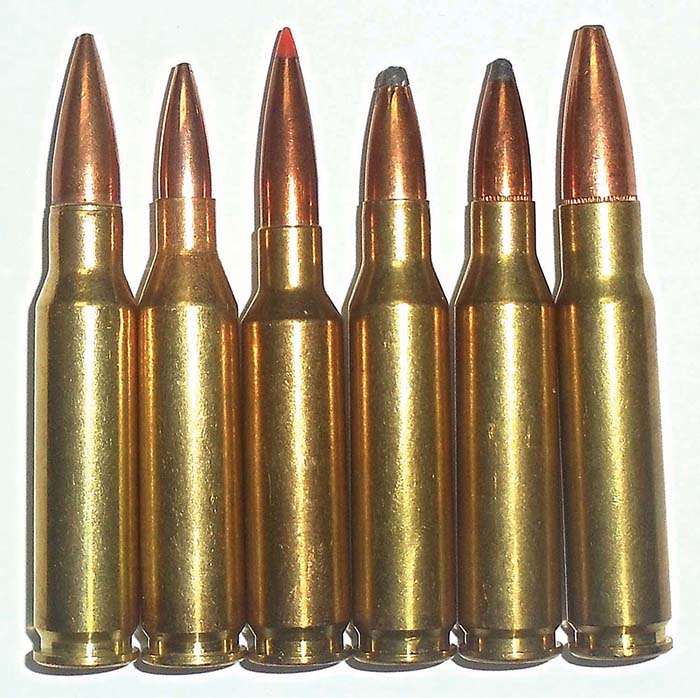
7.62x40mm WT
The 7.62x40mm Wilson Tactical was developed with a similar concept as the 300 Whisper/300 AAC Blackout in offering a .30 caliber alternative in the black rifle that was easily integrated into the system (same bolt and magazines). It was designed with a tactical application in mind but with this bullet type medium size game was also in reach. Ballistics is comparable to the 6.8mm SPC cartridge out to 175 to 200 yards. The cartridge can be loaded with soft point and hollow point projectiles for terminal performance as well as Barnes TTSX projectiles for barrier penetration. The cartridge is a wildcat, made from a 5.56x45mm cartridge case. It is cut down to 1.560 “and the mouth is resized to accept a .308-inch diameter projectile. Normally, the cartridge will stabilize reliably 110 to 150 grain projectiles with the optimal rifling twist being 1/11 or 1/12. The 125 grain projectile is launched at 2,400 feet per second from a 16 inch barrel in the 7.62×40 WT as opposed to 2,215 feet per second from the 300 AAC Blackout cartridges. Like the 300 Whisper/300 AAC Blackout, if the shooter wishes to fire heavier subsonic ammunition the much faster 1/8 twist is required. Loaded ammunition is only sold by Wilson Tactical.
The 7.62x40mm cartridge can provide slightly more velocity than the 300 Whisper/300 AAC Blackout due to the case being 5mm longer. Other than the barrel, the magazine suggested is a Lancer L5 magazine if downloaded to 17 rounds in a 20-round magazine or 24 rounds in a 30-round magazine. Wilson Combat has modified the newer Lancer L5 AWM magazines with an 18/19 or 28/29 round capacity and they claim for this to be an ultra reliable combination. This round requires a reloader to keep it running but for one who enjoys that, this will be a very viable caliber.
.338 Spectre
The .338 Spectre cartridge was developed in 2005 specifically for the AR-15 family of gas-operated, detachable-box magazine-fed firearms. The cartridge is intended to fill the gap between traditional pistol caliber cartridges and existing rifle cartridges used in this weapon system. It shares rim size with the Remington 6.8x43mm SPC cartridge, allowing use of OEM bolts in this caliber.
By offering ballistics similar to the .357 Maximum, the .338 Spectre, besides being an excellent caliber for tactical applications, it also offers great potential as a single shot, silhouette and small game cartridge. By using .338 caliber bullets, the cartridge offers a nice variety in projectile choice, ranging from 160-grain Barnes X Spitzers, through 180-grain BST to 300-grain HPBT MatchKing rifle bullets. Furthermore, it allows the user to employ existing suppressors for the 9mm without modification, providing enhanced tactical firepower.
Standard .223-caliber AR-15 magazines will accept a limited number of .338 Spectre cartridges, whereas the 7.62×39 magazines are fully compatible. Due to the fact that the cartridge shares rim and head dimensions with the new 6.8×43 SPC, the preferred magazines are those made specifically for the 6.8×43. The standard .223 lower receiver for the AR-15 can be used without modification and the rifle will function in both semi and full automatic modes. In addition to the AR-15 weapons platform, several other types of firearms can be made to accept this cartridge, including the Mini-14, T/C Encore and various bolt and pump action rifles.
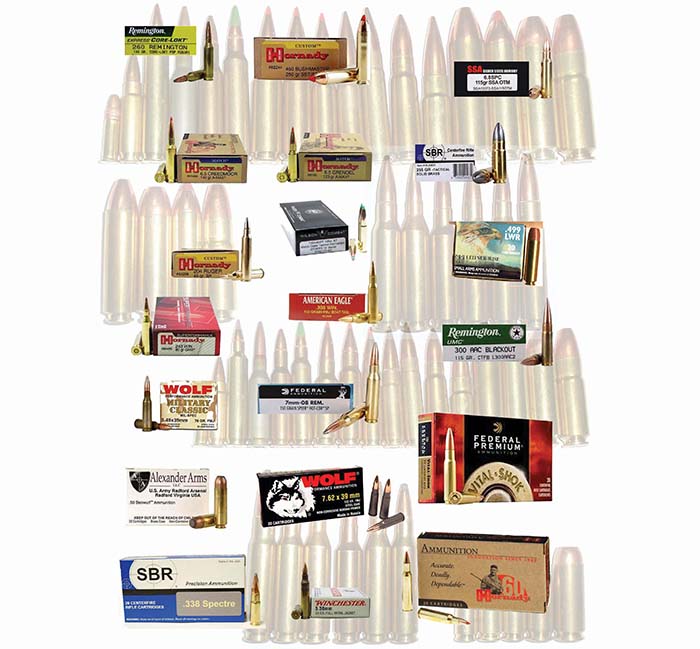
.499LWR (12.5x44mm)
Development of this cartridge began in 1994 by Paul Leitner-Wise of the Leitner-Wise Rifle Company (not to be confused with the current LWRCI Company). There is some lineage to the .50 Beauwolf but only similarities in concept shared with the designer, Bill Alexander of Alexander Arms. The push for the cartridge came from a requirement the US Coast Guard had for a hand held small arm that could sink a small ship and could also be used for line throwing. The .499 LWR cartridge held a 300 grain projectile. Original projectiles proved to be troublesome. They were manufactured from a copper-tin alloy. Though giving an impressive 2,182 feet per second the projectiles would corrode and being in salt water environment expedited the process. Later projectiles were manufactured by Barnes, a solid copper projectile with a more conventional ogive. Also produced was an armor piercing – it was a Barnes bullet with a steel core in the center sticking out of the hollow tip of the projectile. For a brief time a copper-polymer projectile was produced marketed as frangible.
The cartridge never gained much popularity for several reasons. The rifles that shot it were not reliable as it was a combination of the design of the cartridge case and the chamber. The rifle would experience failures to chamber after firing a few rounds. The copper-polymer ammunition left significant fouling in the throat of the barrel. Topped by the corrosive projectiles made the formula of disaster. After being plagued with problems the Coast Guard dropped the program and the .499 LWR went right after it. As of this writing, the ammunition is very rare. Occasionally it may be produced by Silver State Armory. Silver State does still offer new cartridge cases. The design was never finalized nor the bugs worked out. The .50 Beowulf does everything the .499 LWR did but does it repeatedly and reliably. The .499 LWR was the true pioneering round of the big bore AR.
.450 Bushmaster
The .450 Bushmaster started out as the .45 Professional designed by LeMag Firearms LLC and licensed to Bushmaster Firearms for production and distribution. Bushmaster went to Hornady to manufacture the ammunition and their engineers chose to shorten the case to accommodate their 250 grain pointed SST flex tip bullet. The modified round was renamed the .450 Bushmaster. The 250 grain projectile has a muzzle velocity of 2,214 out of a 20-inch barrel with 2,722 foot pounds of energy.
The .450 Bushmaster was designed as a hunting cartridge that would drop big game animals with one shot at 250 yards, in a semiautomatic rifle. Bushmaster offers the rifle in both 16 and 20 inch configurations. The standard 20-round magazine is used with a modified follower. Ammunition is available by both Hornady and Remington. Remington offers a 260 grain Accutip load. This is an excellent performing round and ammunition is available. For the big game hunter, this round should do it all.
.458 SOCOM
The .458 SOCOM was developed by Marty ter Weeme, founder of Teppo Jutsu LLC in 2000. The impetus was an informal (beer and barbeque) discussion with a senior member of the U.S. special operations community regarding the apparent lack of effectiveness of the 5.56×45 cartridge in recent conflict. In particular, the reports from members of Task Force Ranger in Mogadishu, Somalia that multiple shots were required to neutralize members of the opposing force led to the request to develop a new cartridge that would deliver far more energy from short barrels at relatively short distances. After the design was completed, the first prototypes were built and tested. Based on the favorable reviews, commercial production was started and the initial rifles were produced by Teppo Jutsu LLC. Currently, several firms offer rifles or upper assembles in this caliber, including AR-15s, AK-47s, single shot and bolt action rifles.
Working closely with Marty ter Weeme, Southern Ballistic Research, LLC (aka SBR) began extensive cartridge research and development for .458 SOCOM ammunition in 2003. Currently SBR produces over 20 different types of .458 SOCOM ammunition, ranging from 250 gr. up to a 500 gr. subsonic, as well as some LEA/GOVT restricted cartridges (AP & API). SBR has also developed a sound suppressor specifically designed for the 458 SOCOM cartridge.
.50 Beowulf
The .50 Beowulf was developed by Bill Alexander of Alexander Arms in 1999. The cartridge case was based on the .50 AE pistol round. The cartridge case was modified in that the rim was rebated to fit in a standard 5.56mm bolt and the cartridge case was made as long as possible to increase powder capacity and still with the projectile fit in the magazine. Many cartridges followed this pioneering move to make the largest possible cartridge that could be fired in a standard AR-15-type rifle. These cartridges following this design/concept would be the .499 LWR, .450 Bushmaster and .458 SOCOM. Projectile weight ranges from 300, 325, 334 and 400 grains with projectile types being Gold Dot jacketed hollow point, Unicor, hollow point, full metal jacket and soft point. The Beowulf delivers a 300 grain projectile at a muzzle velocity of 1,900 feet per second and a 400 grain projectile at 1,800 feet per second.
Rifles are manufactured by Alexander Arms. The rifle uses a standard bolt with a barrel chambered for the Beowulf. The magazine is slightly modified to accept the Beowulf cartridge. Rifles have also been manufactured by Umlaut.
Pistol Cartridges
9x19mm, .40 S&W, 45 Auto, 5.7x28mm & .50 AE
The Black Rifle was first introduced by Colt in 9x19mm as the Colt SMG. The SMG was blowback operated and had a magazine insert in the magazine well to accept a slightly modified Uzi magazine. The SMG has gone through several improvements over the years. Colt has sold the SMG’s to SWAT teams all over the world as well as some military sales. They were sold in both 10.5 inch and 16.1 inch barrels. Other companies have produced upper receivers as well as complete rifles in 9x19mm such as Olympic Arms, Spikes Tactical, Rock River Arms, CMMG and Double Diamond. Most of these will work reliably with 9mm ball ammunition but may have difficulty firing hollow point ammunition reliably.
Many companies throughout the years have produced .22 LR caliber variations of the Black Rifle. At first a conversion bolt carrier and magazine were offered. Colt sold a conversion kit for quite some time. The first complete rifle based on research was done by Diemaco in Canada called the C10 training rifle. This was a dedicated .22 LR caliber rifle for use in indoor ranges. The prototype rifle was also shown by Paul Leitner-Wise in SHOT 2002 but to my knowledge was never sold. Complete rifles and conversion uppers have been manufactured by Smith & Wesson, Umarex, CMMG, Mossberg, Chippa, Tactical Solutions, Mitchell Arms and Ruger to name a few.
The popularity of the .40 and .45 caliber ammunition has also sparked the design of AR uppers and carbines to shoot these cartridges. Both Rock River Arms and Olympic Arms have produced both uppers and complete rifles. Luvo arms and Lone Wolf have also manufactured a .40 caliber carbine.
The large .50AE cartridge has also been chambered in an AR by RMW Extreme and Hesse Arms. This has not been a very popular caliber in this weapons platform but a couple have done it.
The 5.7x28mm upper conversion has been for sale by PW Arms. This conversion takes a FNH PS90 magazine. Not very popular but for one who likes this caliber, there is an option.
AR-10 Platform
Although the AR-15 started out as the AR-10 chambered in 7.62x51mm and was cast into the pits of the Ordnance Corps in the late 1950s, it has come back in the early 1990s and with a vengeance. With the larger cartridge, the AR-10 is just as versatile as the smaller AR-15 little brother. Due to it being larger, by nature not nearly as much as been done with it, but several cartridges are compatible with the system and I am sure more to come.
7.62x51mm/.308 Winchester
The original chambering of the AR-10 was the NATO standard 7.62x51mm cartridge until the Air Force requested the rifle be scaled down resulting in the AR-15 in 5.56x45mm caliber. In the 1950s the U.S. Ordnance Corps rejected the AR-10 and placed this incredible futuristic weapon in the scrap heaps of Ordnance Corps. And it wasn’t until the early 1990s when Gene Stoner and Reed Knight, Jr. reintroduced it as the SR-25. Now the AR-10 design is made by numerous companies and is used as a sniper weapon by the government/Army that rejected it in the 1950s. By the chamber being compatible both with 7.62x51mm and commercial .308 Winchester ammunition, this cartridge has become one of the most popular in the country and is used for everything from a combat round, sniper round, self defense, hunting and competition to a plinking round. Bullet projectile weight can range from 110 to 190 grains. Primary military load is the M80 ball firing a 147 grain full metal jacket at 2,800 feet per second. Other military loads are the M118 169gr OTM and the M118LR 175gr OTM. Commercial ammunition is loaded in any configuration imaginable from standard hollow and soft points to barrier, ballistic tip, Barnes solid copper, partition, among many, many others.
The standard AR-10 is not finicky to what ammunition it is fed and this author has fired an overabundance of commercial ammunition through the LMT LM308MWS, ArmaLite AR-10, LWRCI REPR, SIG 716, HK417 and SCAR Heavy, to name a few, and encountered little to no issues with ammunition compatibility.
.243 Winchester
The .243 Winchester is one of the most popular cartridges in the U.S. and in the UK. This caliber is probably the minimum you would want to go after deer. The .243 Winchester is a necked down .308 Winchester caliber cartridge case to accept the .243 diameter projectile. Due to restrictions of military calibers in several countries the 243 Winchester is used in lieu of .308 Winchester. This cartridge has seen limited use as a law enforcement sniper cartridge as well. Commercial loads are found with projectile weights of 55, 58, 62, 75, 80, 85, 90, 95 and 100 grains. Projectiles can be found in any configuration due to this caliber’s popularity. The .243 Winchester cartridge pushes a 95 grain projectile up to 3,203 feet per second. All major small arms ammunition makers manufacture this cartridge.
Due to the parent case being a .308 Winchester, this cartridge has been adapted to the AR-10 platform of weapons by only replacing the barrel. The same bolt and magazine are used with the .243 Winchester as the .308 Winchester/7.62x51mm cartridge. AR10-type rifles in .243 Winchester have been produced by ArmaLite, LMT (MRP), Remington, DPMS to name a few. The light recoil and accuracy of this round make an ideal hunting varmint/deer size game.
.260 Remington
The .260 Remington was introduced by Remington in 1997. This was a successful wildcat cartridge based off of the .308 Winchester cartridge necking it down to accept the .264-inch diameter projectile. After gaining SAMMI acceptance, the rifle and cartridge could be manufactured with standard specification unlike the earlier wildcat configuration. This cartridge is also able to duplicate the trajectory of the .300 Winchester Mag cartridge. Factory loads have projectile weights from 120 to 140 grains. Reloaders can go as high as 160 grains. A Remington 120 grain Accutip fires with a muzzle velocity of 2,930 feet per second. Projectiles range from open tip match, soft point, ballistic tip, Barnes Triple Shot-X and Sierra GameKing to name a few. Ammunition is manufactured by Remington, Corbon, Federal, Blackhills, HSM, Nosler and Grizzly Ammunitions.
Due to the parent case being the .308 Winchester the cartridge is easily adapted to the AR-10-type rifle. The same bolt and magazine are used – only the barrel need be changed. Rifles have been manufactured by ArmaLite, LMT (MRP), DPMS and Remington. Barrels are available to change virtually any AR-10-type rifle into one chambered in the .260 Remington caliber. This caliber has been used in tactical rifles, competition rifles as well as hunting rifles. The power and range of the cartridge make it suitable for large deer, moose, elk and with the lighter projectiles varmints, bobcat and coyotes. Ammunition is readily available for this excellent versatile cartridge.
7mm-08 Remington
Based on a wildcat cartridge from the late 1950s the 7mm-08, the parent .308 Winchester cartridge case is necked down to accommodate the .284” diameter projectile. Bullets weigh from 100 to 175 grains. Projectiles from 154 to 175 grains can be used medium to some large game. The 100 to 140 grain projectiles work well for varmints. Longer range shooters will opt for the 175 grain projectiles. Its trajectory is comparable to the .270 Winchester. The light recoil and short action make this ideal for an autoloading rifle as well. Projectiles vary from soft point, Hornady SST, Barnes Triple-Shock X, Spitzer, ballistic silver tip, Accubond as well as partition to name just a few. Loaded ammunition is provided by many manufacturers including Remington, Winchester, Hornady, Prvi Partizan, Federal, Barnes, Nosler and HSM, among others.
Rifles based on the AR-10-platform have been manufactured by Remington, Rock River and LMT (MRP). Any AR10-type rifle is easily converted to 7mm-08 by just replacing the barrel. The same bolt and magazine are used due to the .308 being the parent cartridge case.
.338 Federal
The .338 Federal cartridge was a joint effort between Federal and SAKO in 2006 to introduce a .308 cartridge case necked up to accept the .338 caliber projectile. This allowed for a lightweight rifle to be matched with a big game cartridge. More potent than the .308 Winchester, this cartridge can be easily placed in a AR-10 platform by only swapping out the barrel since the cartridge case is based on the .308 Winchester. Commercially loaded projectile weights are 185, 200 and 210 grains and available in Accubond, partition, soft point and Barnes solid copper configurations. As of this writing Federal is the only company making this caliber of ammunition.
Rifles have been manufactured in this caliber by ArmaLite, DPMS, LUVO and LMT (MRP). This is an excellent cartridge, very pricey on the ammunition but powerful and in the AR-10 platform very comfortable and controllable. This cartridge could take any game in North America.
6.5 Creedmoor
Introduced by Hornady in 2007, the 6.5 Creedmoor cartridge provided the same trajectory of the 300 Winchester Mag with far less recoil. According to Hornady this was the first cartridge developed from the ground up to be a match cartridge out of the box. The original goal was to provide a match shooter with an out of the box cartridge they could compete with Winchester at the highest levels of match shooting. The short action length of the cartridge case allowed it to be used in the AR-10-type rifle by only changing the barrel. Recoil in the semiautomatic platform made this a pleasant cartridge to shoot. Ammunition is primarily only made by Hornady. Projectile weights include 120, 129 and 140 grains. Cartridges offered by Hornady are the Superformance line of ammunition. Loaded with both the new 120 grain GMX and the venerable 129 grain SST, the 6.5 Creedmoor brings a world of precision-based performance to the hunting arena. The 120 grain projectile is launched at a muzzle velocity of 2,910 feet per second out of a 24 inch barrel.
Due to the cartridge being based off of the .308 Winchester cartridge case, only the barrel needs to be replaced on an AR-10-type rifle. The same bolt and magazine are used. Rifles have been manufactured in this caliber by DPMS, LMT (MRP), Fulton Armory and Sabre defense and Noveske.
As clearly seen, the modularity and adaptability of this family of weapons is second to none. I am sure there are some calibers that I have missed or left out. As of this writing, Olympic Arms just entered a 22-250 caliber rifle in the AR-platform. I had run across a 6mm PPC as well but these have been less than popular. There is no doubt when the AR-family of weapons is called the grown mans erector set. There is little you cannot do with a good imagination and a good gunsmith.
| This article first appeared in Small Arms Review V17N2 (June 2013) |



